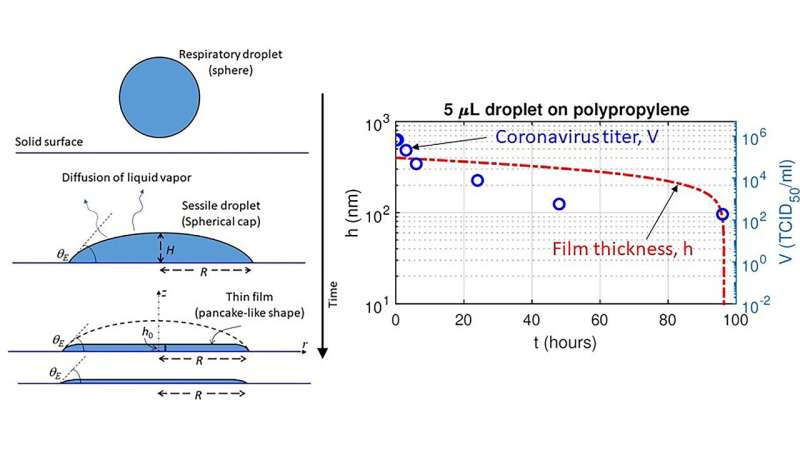COVID-19 virus survives on surfaces within thin film

How does the COVID-19 virus manage to survive on surfaces? To find out, researchers in India are exploring the drying times of thin liquid films that persist on surfaces after most respiratory droplets evaporate.
While the drying time of typical respiratory droplets is on the order of seconds, the survival time of the COVID-19 virus on different surfaces within recent experiments was found to be on the order of hours. This discrepancy suggests an orders of magnitude difference in the time between droplet drying and the survival time of the COVID-19 virus on surfaces.
In Physics of Fluids, Rajneesh Bhardwaj and Amit Agrawal, professors at IIT Bombay, describe how a nanometers-thick liquid film clings to the surface, due to London-van der Waals forces, which allows the COVID-19 virus to survive for hours.
"To describe this thin film, we used tools that are otherwise seldom used by researchers within the engineering realm," said Bhardwaj. "Specifically, we developed a computational model for the evaporating mass rate of the film as a function of disjoining and Laplace pressures inside the film, using the Hertz-Knudsen law, a well-established kinetic theory of gases."
The nanometric film is assumed to be like a pancake deposited onto a surface. The researchers briefly examined changes in drying time as a function of contact angle and surface type.
"Our model for the thin film transport shows that survival or drying time of a thin liquid film on a surface is on the order of hours and days, similar to what has been observed in measurements of the virus titer [the lowest concentration of virus that still infects cells]," said Agrawal. "It captures the relatively longer survival time on plastic and glass compared to metals."
The ability to predict the survival of a coronavirus on different surfaces can help prevent and contain the spread of COVID-19. This work provides insights into how the COVID-19 virus survives for hours or days on solid surfaces under ambient conditions.
"Our biggest surprise was that the drying time of this nanometric film is on the order of hours," said Bhardwaj. "It suggests the surface isn't completely dry, and the slowly evaporating nanometric film is providing the medium required for the survival of the coronavirus."
Since a longer survival time of the virus corresponds to increased chances of being infected, "it is desirable to disinfect frequently touched surfaces, such as door handles or hand-held devices, and within hospitals and other areas prone to outbreaks," said Agrawal.
"We also recommend heating surfaces, because even short duration high temperatures, at which the surface is at a higher temperature than the ambient, can help evaporate the nanometric film and destroy the virus."
More information: How coronavirus survives for days on surfaces, Physics of Fluids, aip.scitation.org/doi/10.1063/5.0033306
Journal information: Physics of Fluids
Provided by American Institute of Physics





















